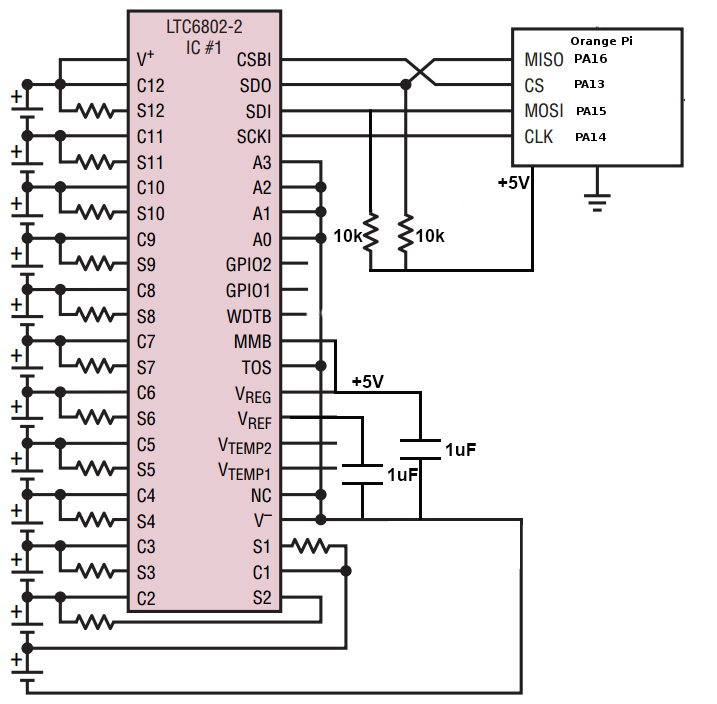LTC6802
The LTC6802 is a complete battery monitoring IC that includes a 12-bit ADC, a precision voltage reference, a high voltage input multiplexer and a serial interface. Each LTC6802-2 can measure up to 12 series connected bat-tery cells with an input common mode voltage up to 60V.
LTC6802 is a great option if you want to build battry monitoring system with more accuracy. This IC operates on SPI protocol.
The datasheet for LTC6802-2 can be found at here
Following figure shows the circuit diagram to interface the LTC6802-2 with Orange Pi zero.

After mounting the IC on PCB it looks like this.

Interfacing with Orange-Pi
In order to access the data from IC over SPI, I’m using periphery.
to install periphery:
$ pip install python-peripheryTo activate the LTC chip we need to make the CS pin low. To do that I’m using pyA20 library for Orange Pi.
to install pyA20:
$ pip install pyA20The standard procedure to access the data from LTC6802 over SPI is:
make CS pin low.
write the data/command to SPI.
read the output from the SPI.
make CS pin high.
Since the circuit and the dependencies are in place, let’s start coding.
#!/usr/bin/env python
# -*- coding: utf-8 -*-
from periphery import SPI
from pyA20.gpio import gpio as io
from pyA20.gpio import port
import time
cs = port.PA13 # Chip select pin
spi = SPI("/dev/spidev1.0", 0, 1000000) # Spi port
io.init() # init GPIO
io.setcfg(cs, io.OUTPUT) # configure cs Pin as output pin.
RDCV = 0x04 # Read cells
STCVAD = 0x10 # Start all A/D's - poll status
address = 0x80 # as we are connecting only one IC the address is 0x80
# refer the datasheet for the details about addressing of LTC6802
# refer datasheet for more details about configuration.
Config = [0x01, 0x01, 0x00, 0x00, 0x00, 0x71, 0xAB]
def writeCfg():
"""
Writes the configuration to IC.
"""
io.output(cs, io.LOW) # make CS low
data_in = spi.transfer(Config) # write the config to IC and read the OP
io.output(cs, io.HIGH) # make CS high
def readVoltage():
"""
Returns a dictionary containing the voltages of 12 battries.
"""
v = {}
io.output(cs, io.LOW) # make CS low
data_out = [STCVAD]
data_in = spi.transfer(data_out) # start all A/D
time.sleep(0.02)
io.output(cs, io.HIGH) # make CS high
io.output(cs, io.LOW) # again make CS low
spi.transfer([0x80]) # write the address 0x80 to SPI
spi.transfer([RDCV]) # (command to) read cells
data = []
for i in range(18): # read 18 bytes from the IC
data.append(spi.transfer([RDCV]))
io.output(cs, io.HIGH)
# refer the datasheet of LTC6802 for conversion of ADC value to Voltages.
# here we are calculating voltages from ADC values of all 12 battries.
v['0'] = ((data[0][0] & 0xFF) | (data[1][0] & 0x0F) << 8)*1.5*0.001
v['1'] = ((data[1][0] & 0xF0) >> 4 | (data[2][0] & 0xFF) << 4)*1.5*0.001
v['2'] = ((data[3][0] & 0xFF) | (data[4][0] & 0x0F) << 8)*1.5*0.001
v['3'] = ((data[4][0] & 0xF0) >> 4 | (data[5][0] & 0xFF) << 4)*1.5*0.001
v['4'] = ((data[6][0] & 0xFF) | (data[7][0] & 0x0F) << 8)*1.5*0.001
v['5'] = ((data[7][0] & 0xF0) >> 4 | (data[8][0] & 0xFF) << 4)*1.5*0.001
v['6'] = ((data[9][0] & 0xFF) | (data[10][0] & 0x0F) << 8)*1.5*0.001
v['7'] = ((data[10][0] & 0xF0) >> 4 | (data[11][0] & 0xFF) << 4)*1.5*0.001
v['8'] = ((data[12][0] & 0xFF) | (data[13][0] & 0x0F) << 8)*1.5*0.001
v['9'] = ((data[13][0] & 0xF0) >> 4 | (data[14][0] & 0xFF) << 4)*1.5*0.001
v['10'] = ((data[15][0] & 0xFF) | (data[16][0] & 0x0F) << 8)*1.5*0.001
v['11'] = ((data[16][0] & 0xF0) >> 4 | (data[17][0] & 0xFF) << 4)*1.5*0.001
return v
def readVal():
while True:
writeCfg()
time.sleep(0.001)
v = readVoltage()
print(v)
time.sleep(1)
if __name__ == '__main__':
readVal()
The minimum operating voltage of LTC6802 is 10V.
Make sure that total voltage of all the battries combined together is more than 10V.